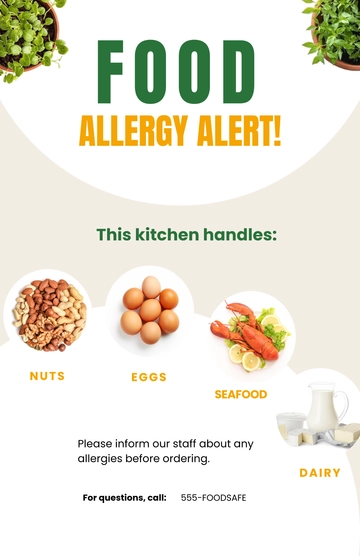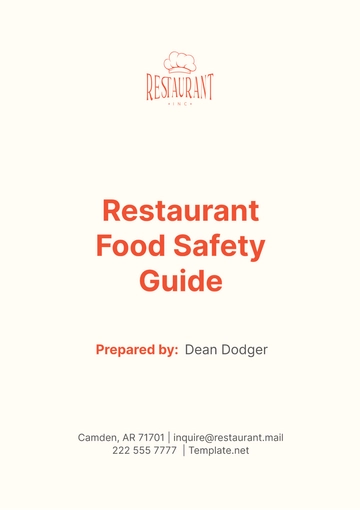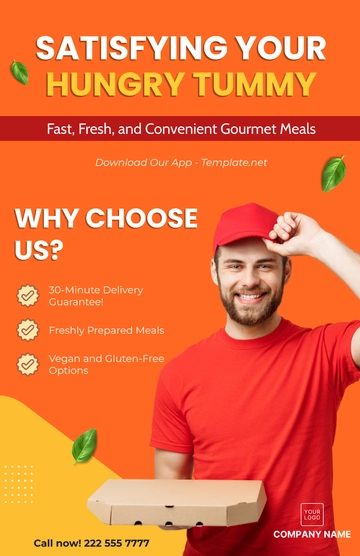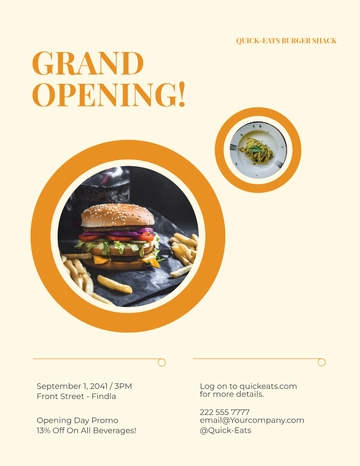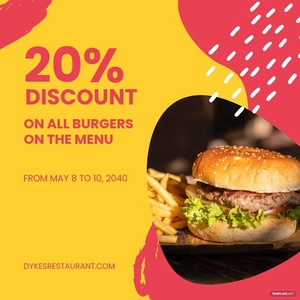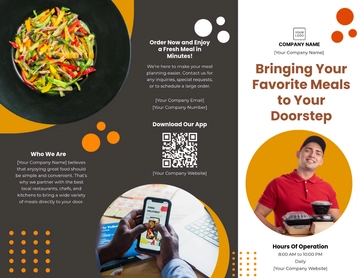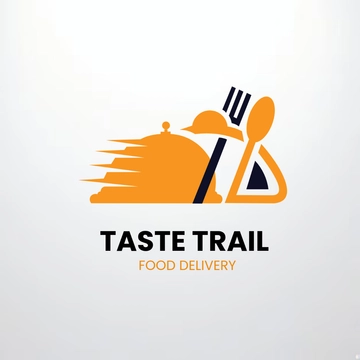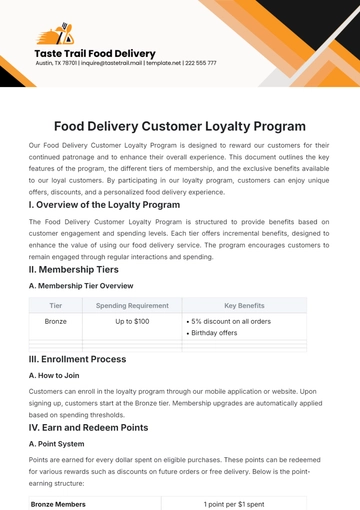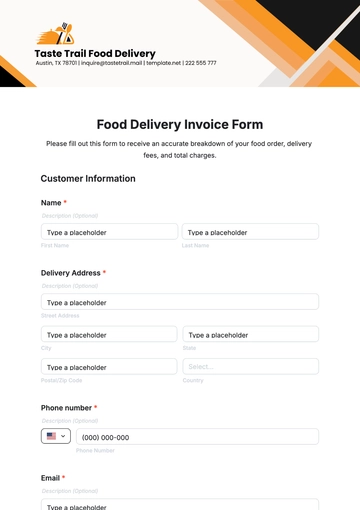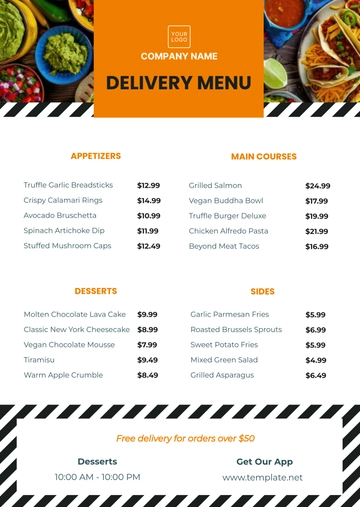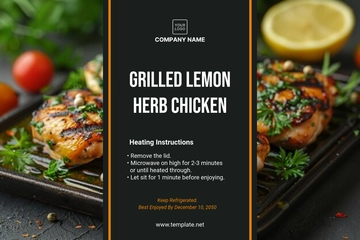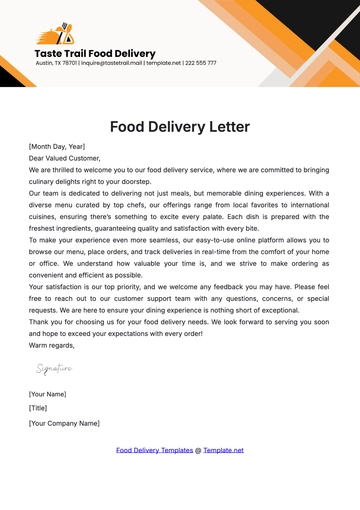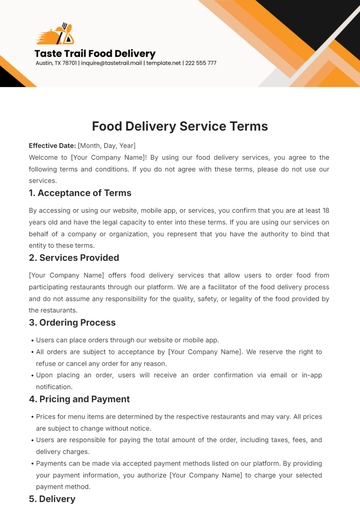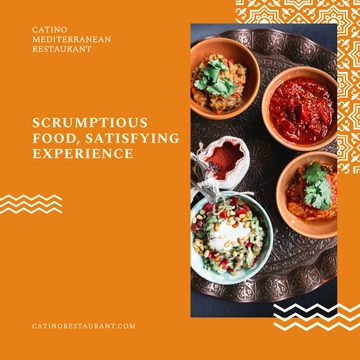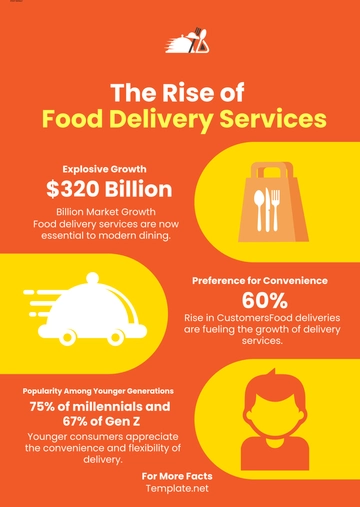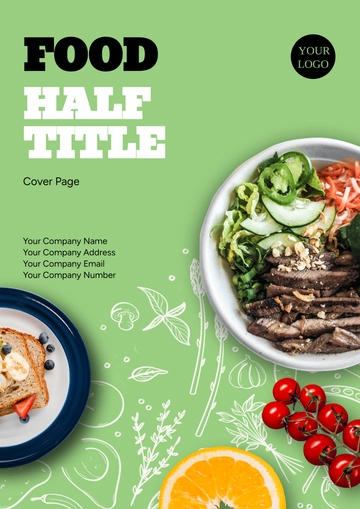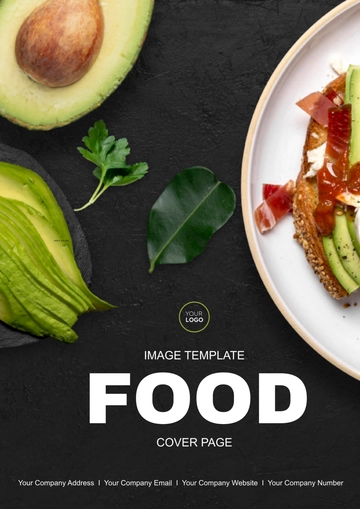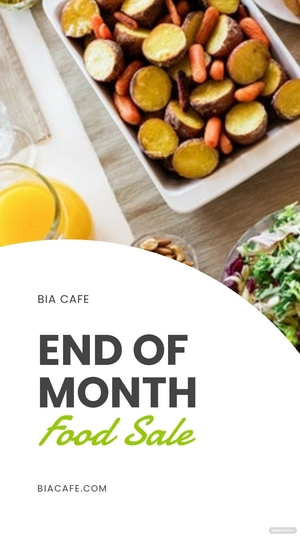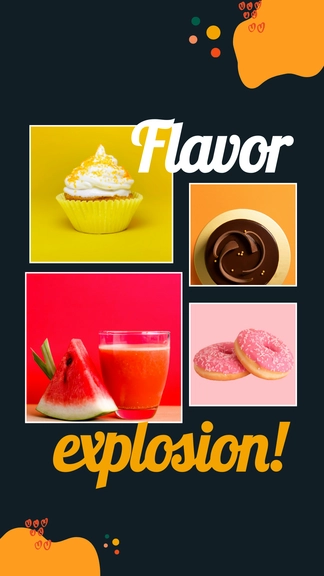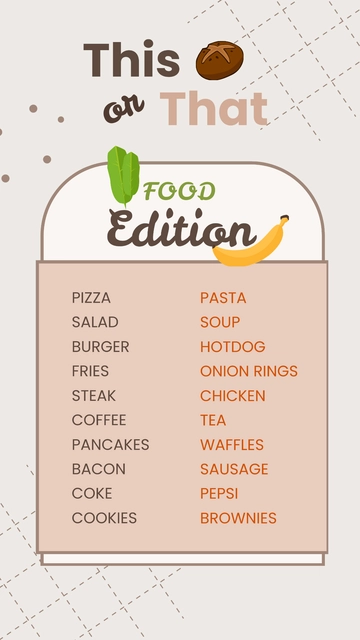Free Restaurant Weekly Planning Guide
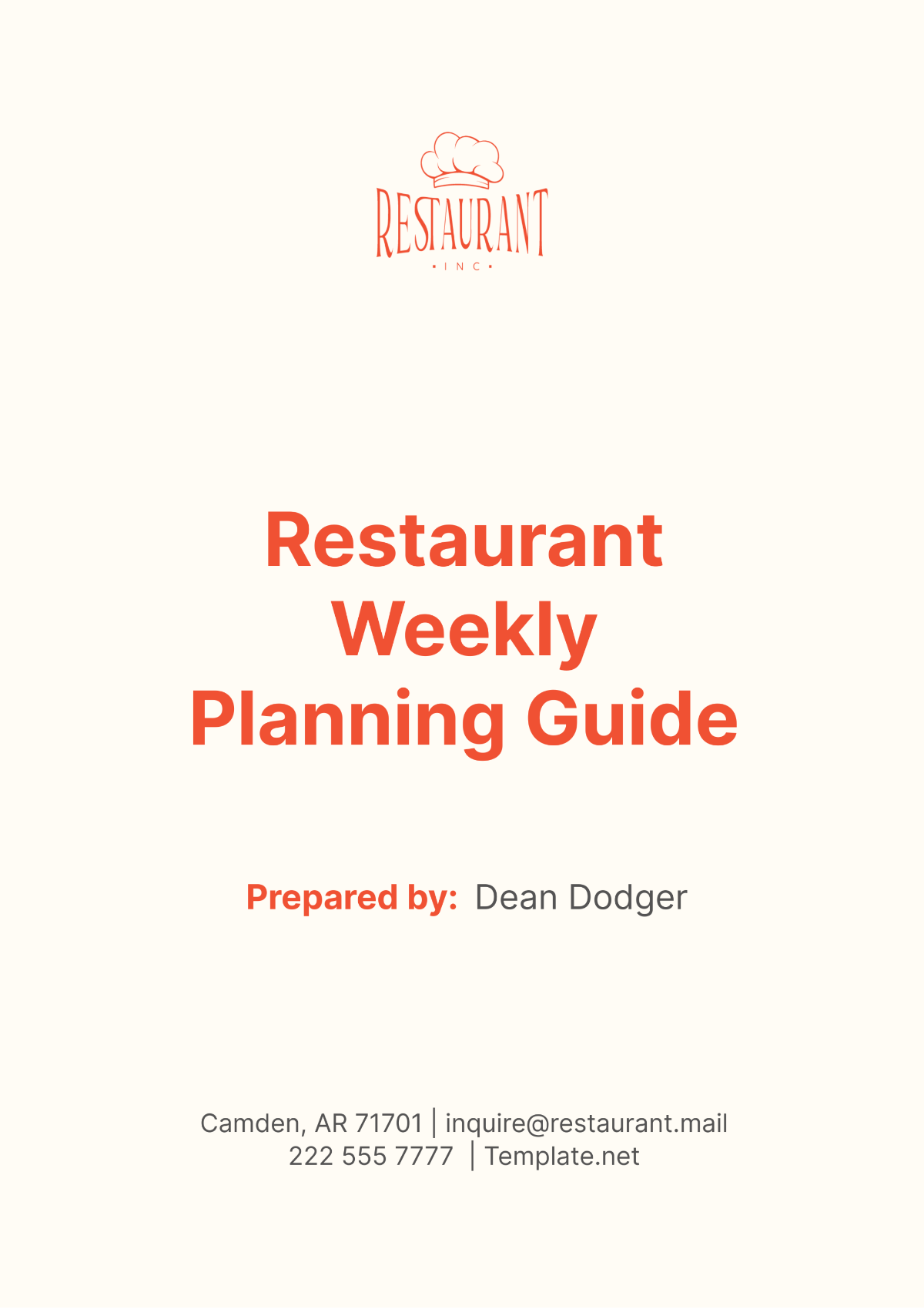
This Restaurant Weekly Planning Guide provides a comprehensive framework designed for [Your Company Name] to streamline operations, boost efficiency, and enhance customer satisfaction. By following this guide, your team will be well-equipped to handle the weekly demands of the restaurant effectively.
I. Weekly Sales Analysis
Last week's sales analysis provides essential insights into [Your Company Name]'s performance, highlighting areas of strength and potential growth. The total revenue reached $15,000, a robust figure that demonstrates effective customer attraction and retention strategies. Most notably, orders for the signature seafood platter increased by 20%, suggesting high customer satisfaction and demand for this dish. The method of collecting customer feedback through digital surveys has proven effective, yielding actionable data that informs our menu and service adjustments.
This detailed examination of sales trends allows us to pinpoint successful elements of our business model and areas where strategic changes could drive further success. The increase in seafood platter orders, for instance, indicates a successful promotional strategy or superior product quality that resonates with our patrons. Leveraging this information, future plans will focus on enhancing our culinary offerings and possibly expanding our seafood range to capitalize on this trend. Furthermore, the feedback collected via digital surveys offers a direct line to customer preferences, helping to tailor the dining experience to meet and exceed expectations.
The table below provides a comprehensive breakdown of key metrics from last week's performance. Analyzing this data helps us understand customer behavior and sales trends, which is instrumental in making informed decisions for staffing, inventory management, and marketing efforts. These insights not only help optimize operational efficiency but also enhance customer satisfaction by ensuring popular items are well-stocked and the staff is well-prepared for peak times.
Metric | Value | Analysis |
|---|---|---|
Total Revenue | $15,000 | Steady growth, assess for patterns |
Signature Dish Orders | 20% increase | Evaluate supply chain & promotion |
Customer Feedback Submission | 85% via surveys | High engagement, continue method |
Most Popular Time Slot | 7 PM - 9 PM | Optimize staff shifts & prep |
Least Popular Dish | Veggie Burger | Consider menu adjustments |
This instructional and detailed analysis guides strategic planning and operational adjustments to maintain and enhance the restaurant’s performance.
II. Staff Scheduling Insights
Optimal staff scheduling is pivotal for balancing operational efficiency with employee well-being at [Your Company Name]. By leveraging our predictive analytics tool, we allocate hours that align with the projected customer inflow, ensuring we are well-prepared for busier periods without overstaffing during slower times. This week, our scheduling strategy involved assigning 50 hours on weekdays for an expected 200 diners each day, which optimizes our staff utilization and maintains service quality. On Fridays and Saturdays, though diner numbers differ, we've streamlined hours to 40 each day, reflecting a strategic approach to manage peak times effectively.
Our scheduling insights reveal that while Fridays see fewer diners compared to Saturdays, the complexity and demand of service require similar hours. This consistency ensures that we maintain a high level of customer service during our peak weekend nights. On Sundays, we reduce scheduled hours to 20 in response to a lower expected number of diners (100), which helps control labor costs while meeting service standards. This approach not only aids in cost management but also enhances staff morale by preventing burnout, aligning with our goal of employee satisfaction.
Below is a comprehensive table that breaks down our staffing strategy, offering a clear view of how staff hours are distributed in response to diner expectations. This methodical scheduling aids in maintaining a balance between adequate coverage during busy periods and efficiency during quieter hours, thereby optimizing both customer satisfaction and operational costs.
Day | Expected Diners | Hours Scheduled | Staff Utilization Strategy |
|---|---|---|---|
Weekdays | 200 | 50 | Optimize for steady weekday traffic |
Friday | 150 | 40 | Prepare for high demand and complex service |
Saturday | 250 | 40 | Efficient staffing for peak dining hours |
Sunday | 100 | 20 | Scale back to manage lower traffic |
This detailed approach to staff scheduling ensures that [Your Company Name] efficiently manages resources, enhances employee satisfaction, and consistently delivers excellent service to our patrons.
III. Inventory Management
Effective inventory management is crucial for [Your Company Name] to ensure that our kitchen remains prepared for fluctuations in dish popularity, particularly our well-loved seafood offerings. Currently, our stock of fresh salmon is 30% depleted, reflecting a significant increase in demand, especially for our signature seafood platter. To address this, we have decided to reorder 50 pounds of salmon, which is calculated based on recent sales trends and projected future demand. This proactive approach helps prevent potential shortages and ensures that we can continue to offer our popular dishes without interruption.
This strategic inventory adjustment not only secures our ingredient supply but also supports our commitment to serving high-quality and fresh dishes. By monitoring our stock levels closely and responding swiftly to changes in consumption patterns, we maintain an efficient flow of ingredients that aligns with both current and anticipated customer preferences. This method also aids in minimizing waste by ensuring that we order quantities that closely match our needs, based on precise and timely data analysis.
Below is a detailed table that illustrates our current inventory status and the actions we are taking to manage it effectively. This table serves as a tool for tracking ingredient levels and guiding our ordering decisions, ensuring we are always prepared for customer demand while managing costs effectively.
Ingredient | Current Stock | % Depleted | Reorder Quantity | Rationale |
|---|---|---|---|---|
Fresh Salmon | Sufficient | 30% | 50 pounds | Match increased demand for seafood dishes |
Beef | Adequate | 15% | 30 pounds | Stock up for upcoming menu specials |
Vegetables | Low | 40% | 60 pounds | Prevent shortages due to high salad sales |
Spices | Sufficient | 5% | 10 pounds | Maintain consistent flavor profiles |
Dairy | Adequate | 20% | 25 pounds | Support dessert and sauce preparations |
This table reflects a detailed approach to managing each ingredient based on its usage rate and anticipated needs. It aids in ensuring that all necessary components are available in the kitchen, preventing disruptions in service and maintaining the high quality of dishes offered.
Additional Explanation for Inventory Management Strategy:
Beef: With a current depletion of 15% and a reorder of 30 pounds, we anticipate an increase in demand for beef dishes due to a seasonal menu change that introduces several new beef-based specials. This proactive stocking ensures we are prepared for customer interest in these new offerings.
Vegetables: Our vegetables are 40% depleted, prompting a reorder of 60 pounds. This substantial restock is in response to a surge in salad orders with the warmer weather. Keeping a robust stock of fresh vegetables is critical to meeting our commitment to fresh, healthy menu options.
Spices: A minimal depletion of 5% reflects stable demand, but a small reorder ensures we do not run out of essential spices that are critical for maintaining the flavor profiles our customers expect.
Dairy: The 20% depletion and subsequent reorder of 25 pounds of dairy products support not only our dessert menu but also the preparation of various sauces that are integral to our main dishes.
This comprehensive inventory management ensures that [Your Company Name] operates efficiently, reduces waste, and continually meets the expectations of our customers with top-quality dishes.
IV. Weekly Team Meeting Agenda
The weekly team meeting at [Your Company Name] serves as a crucial platform for communication and collaboration, ensuring all team members are aligned and motivated. Below is the agenda for this week's meeting, meticulously structured to cover vital topics that will enhance our operational excellence and staff morale:
Introduction of the New Seasonal Menu: We will start the meeting by unveiling our new seasonal menu. The culinary team will present the new dishes, discuss the inspiration behind them, and explain any preparation techniques that differ from our standard offerings. This introduction will help staff familiarize themselves with the changes and effectively answer any customer inquiries.
Discussion on Recent Changes in Dining Regulations: Next, we will review the latest updates in dining regulations that affect our operations. This segment will include a comprehensive overview of new health and safety protocols, adjustment in seating arrangements, and any changes in service methods. It’s essential that all staff understand these updates to ensure compliance and maintain the safety of both guests and team members.
Feedback Session on Current Restaurant Operations: We will open the floor to a feedback session, inviting comments, observations, and suggestions regarding current restaurant operations. This is an opportunity for staff to voice any concerns they have encountered in their roles, discuss efficiency of the new POS system, or provide insights on customer interactions. This feedback is invaluable for continuous improvement.
Addressing Staff Concerns and Suggestions: Following the feedback session, we will address specific concerns raised by the team. This part of the meeting is dedicated to resolving any issues in a constructive manner and exploring suggestions for improving workplace conditions and operational efficiency.
Staff Recognition and Motivation Initiatives: To conclude the meeting, we will recognize outstanding staff performances and introduce new motivational initiatives. This will include announcements of employee of the month, details on upcoming team-building activities, and information about training opportunities for skill enhancement.
This structured agenda ensures that the meeting is productive and engaging, fostering a positive work environment and encouraging active participation from all team members. It’s designed to not only inform but also empower our staff, reinforcing [Your Company Name]'s commitment to excellence in hospitality.
V. Promotional Activities
Promotional activities are key to amplifying customer engagement and driving traffic to [Your Company Name]. Effective preparation and strategic planning ensure that our marketing efforts resonate with our target audience and boost visibility for upcoming events.
Here's a comprehensive table outlining the tasks and details associated with the promotional activities for the [Event Name] event at [Your Company Name]:
Task | Description | Status | Engagement Goal | Responsible Department |
|---|---|---|---|---|
Finalize Promotional Content for [Event Name] Event | Develop vibrant graphics, engaging copy, and multimedia content to highlight the event's offerings. | In Progress | — | Marketing |
Approval from Management | Ensure promotional materials align with brand standards and messaging; final review and approval. | Pending | — | Management |
Launch Social Media Campaign | Execute a targeted campaign on Facebook, Instagram, and Twitter to generate interest and encourage participation in the event. | Scheduled | 2,000 | Social Media Team |
Details:
Finalize Promotional Content: This involves collaboration between graphic designers, copywriters, and the marketing strategy team to create materials that are both appealing and informative, focusing on the uniqueness of the '[Event Name] menu and the ambiance of the event.
Approval from Management: Critical step to ensure all content is on-brand and up to the quality standards of [Your Company Name] before public release.
Launch Social Media Campaign: This strategic promotion will utilize organic posts, paid advertisements, and engagement tactics such as sharing behind-the-scenes content, hosting live sessions about the menu, and interactive polls or contests to maximize reach and interaction on specified platforms.
- 100% Customizable, free editor
- Access 1 Million+ Templates, photo’s & graphics
- Download or share as a template
- Click and replace photos, graphics, text, backgrounds
- Resize, crop, AI write & more
- Access advanced editor
Streamline your restaurant's weekly operations with Template.net's Restaurant Weekly Planning Guide Template. This editable and customizable template is specifically designed to optimize your scheduling and task management, ensuring a smooth workflow. Editable in our AI Editor Tool, it's tailored to elevate efficiency for all culinary establishments. Enhance your planning process today and watch your restaurant thrive!
You may also like
- Food Flyer
- Food Clipart
- Food Truck
- Food Business Plan
- Food Banner
- Food Checklist
- Food Voucher
- Food Chart
- Food Letter
- Food Log
- Food Ticket
- Food Poster
- Food Brochure
- Food Business Contract
- Food Proposal
- Food Lookbook
- Food Invitation
- Food Budget
- Food Magazine
- Food Calorie Chart
- Food Facebook Post
- Food Label
- Food Catalog
- Food Menu
- Food Drive Flyer

